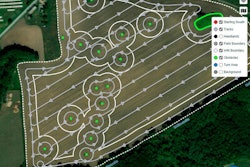
Built assets like buildings and infrastructure are created by a distributed team consisting of architects, engineers, general contractors, subcontractors and project owners, each working for different corporate entities with their own interests and tech stacks. How can the industry drive process improvements, increase productivity and improve quality when multiple contributors are operating on disconnected applications from different vendors?
At Dimensions+ 2022, Trimble announced an enhanced partnership with Microsoft Azure that could address this challenge. Microsoft CEO Satya Nadella appeared on screen during Trimble CEO Robert Painter’s morning keynote on the initial day of the event. This announcement will have far-reaching implications, but already Trimble has delivered an initial set of tools under the initiative.
Initially, Trimble and Microsoft will focus on building the Trimble Construction Cloud powered by Microsoft Azure—including a series of Azure Logic Apps that could be widely adopted in the market. This is part of an overarching trend towards broad construction application suites offering a data abstraction layer in the cloud to unite disparate applications used not only within contractor organizations, but across the extended project team of owners, generals, subcontractors and designers. The ultimate goal of these broad master data management programs is to support the entire built asset lifecycle, including design, construction, post-commissioning maintenance, inspection and even operation.
"Trimble and Microsoft will create a powerful partnership to advance technology adoption in the construction industry. Using Microsoft technologies, Trimble will be able to more rapidly develop a construction cloud to connect stakeholders and workflows throughout the industry," said Bryn Fosburgh, senior vice president, Trimble in a release. "We are building on our combined success to help construction companies use digital data to improve productivity, reduce costs, increase collaboration and create agility. By leveraging the Microsoft cloud, Trimble technology and our combined engineering capabilities, we will empower construction businesses to realize the benefits of the cloud and accelerate digital transformation throughout the construction lifecycle."
Product Released to Market
This sounds not that different from what we hear from a lot of construction technology companies, but Trimble is much better positioned in the market and has as of Dimensions+ 2022 launched initial deliverables and defined a way forward that could extend the addressable market for Trimble Construction Cloud to much of the construction industry.
Trimble is working with Microsoft’s internal team of Azure developers to create a portfolio of connectors and applications but had some initial product to show at the event, including:
- Live Sharing, which enables real-time model collaboration between Trimble and non-Trimble solutions
- Prepackaged workflows already delivered include:
- Model-to-procurement for Mechanical Engineering and Plumbing (MEP)
- Model-to-fabrication for building contractors
- Bid-to-build for civil site management
These tools are available as part of a free trial of Trimble Construction Cloud good through the end of the year. They are being built on Azure Log Apps, a cloud Platform-as-a-Service (PaaS) environment used to automate tasks and workflows. After the free trial, they will be available through the Azure Marketplace on a metered usage pricing model.
“These are self-provisioning apps that take 15 seconds to install,” Trimble Vice President of Product Management Patrick Stevenson said. “We know this puts the onus upon us to make sure these are easy to use.”
Not a New Problem
A number of construction technology vendors have sought to address this data disconnect in various ways for years. Many larger design-build contractors will rely on a collaborative document management application like Newforma Project Center to ensure appropriate team members can access documents stored on computers and networks within the different stakeholder organizations. They may consider a newer, born-in-the-cloud application like Toric, which delivers a low-code, no-code platform connecting disparate data sources into analytical models. Here, we see the evolution from document management and revision control to extracting, harmonizing, scrubbing and standardizing data on an enterprise level to create a shared model.
Procore’s approach to these intra-company transactions is to enable their customers to extend their instance of the software for free to subcontractors and collaborators, but their access to that data may end when the project does. That is why partners like construction analytics vendor Pronovos offers subcontractors the ability to retain data from their Procore projects without a Procore subscription. Autodesk has made similar investments to enable customers to open smaller bits of their Autodesk Build software to subcontractors with Autodesk Bridge. But again, this access to the type of deep project information that would help drive project-over-project improvement asset management insight or more accurate estimating, is hard to come by. And any data that is shared will not gracefully agree in data format, field definitions or data structure with other systems used by each company participating in a project.
Earlier this year, Autodesk ventured into similar territory with the announcement of Forma, its building information management (BIM) data cross organizational and functional boundaries.
“There are many tools you all use today from so many providers—some of them are closed and leave your processes disconnected,” Autodesk CEO Andrew Anagnost said at the launch. “So, you have to pass huge files back and forth and if you do that, you often overshare your IP. Oversharing can get people in trouble, so data gets lost in translation. When data and processes are disconnected, unique insights get lost.”
The overarching goal of Forma is to provide an open, easily manageable data foundation that enables construction project stakeholders to access the relevant data for their part of the project without accessing the entirety of what could be a multi-faceted project with elements that may be proprietary or confidential.
“Forma will transform early stage planning upstream, but will reach downstream,” Anagnost said. “… Our customers will be able to unlock design data and exchange it with external products as a native capability in Forma. So, an engineering company writing terrain data to the cloud can collaborate with external companies on corridor and alignment designs, sharing just the terrain data they need to collaborate.”
READ THE IRONPROS DEEP DIVE ON CONSTRUCTION SOFTWARE INTEROPERABILITY
Trimble Goes It One Better
At Dimensions+ 2022, Trimble did more than define a direction, launching some initial product deliverables at the event.
As announced, Autodesk’s Forma will primarily address interoperability by enabling Autodesk Construction Cloud customers to extend and open slices of their data sets to stakeholders. Trimble Construction Cloud will underpin the Trimble Construction One set of applications but will also be available as a separate service for contractors who just need a data abstraction layer to zip together disparate data sets or internally or across multiple stakeholder organizations.
Perhaps due to their heavy involvement in IoT, Trimble is also pro-open standards and accustomed to meeting the data requirements of diverse external systems.
“No one vendor’s technology can define the way things will be done across the industry,” Trimble Senior Director of Industry Workflows Chris Richardson said. “This is the world we live in at Trimble, because we have always supported BIM standards, and ISO standards for machine control.”
The Trimble execs in our briefing stressed the importance of ISO 1965-1:2018 for Organization and digitization of information about buildings and civil engineering works, including building information modelling (BIM)and pointed out that the data normalization capabilities of Trimble Construction Cloud.
Richardson acknowledges that standards are harder to come by in the back-office, and this creates challenges for contractors with internal transactions and external ones like change orders, applications for payment, requests for information and more.
But despite this lack of standards, Trimble Construction Cloud, according to Richardson, will be able to help contractors round trip estimate data into the field and then report back machine later data on production from connected equipment back to the estimate.
Standards that contractors may want to use Trimble Construction Cloud to conform to for their overall project reporting are still emerging. In other industries like manufacturing, e-commerce between business-to-business entities got a jump start through standards like electronic data interchange EDI requirements and open standards from the American National Standards Institute (ANSI) or ISO 9735 EDIFACT.
In the built space, some early standards adjacent to construction included MIMOSA asset management standard, and one core requirement of the ISO 5500 Asset Management standard is to keep all asset data in a single database across the design, build, operate and maintain lifecycle. But achieving this is difficult when owners, generals, subcontractors, vendors and others are all using disparate applications.
The Construction Specifications Institute has a series of standards.
- Masterformat for architecture, engineering and construction (AEC) specifications and work results on construction projects
- OmniClass for facilities management including databases, software and building information models related to BIM
- UniFormat for building elements, systems and assemblies including foundations, exterior and interior walls, roof systems and HVAC and electrical components
CSI has also launched a lightweight application called Crosswalk that extends Microsoft Word to translate construction documents from one of their standards to another and into applications as necessary through an API. So even in the tightly defined set of standards for specifications that CSI deals with, there is the need to either make data conforming to different standards or different versions or releases of the same standard to agree with each other. Regardless of what standards an owner and its contractors and subcontractors agree on, there will be a need to harmonize the data in proprietary systems run by each trading partner to meet the standard. Something like Trimble Construction Cloud could be an ideal solution that creates this shared model while preserving the data sovereignty and digital self-determination of each contractor.
“This is good for the industry," Toric CEO Thiago Da Costa said. Toric is in essence a competitor for what Trimble Construction Cloud is on track to become. "Tomorrow will look very different than today. Standards, more tools, and cross-company initiatives to make data more accessible helps. Ultimately, the space will be defined by the value that people can extract from data they own. The outcome of integrating, connecting and transforming data that can be easily visualized is what we are all about at Toric. We are excited to partner with the whole industry to help transform data into key outcomes.”
BOTTOM LINE: Trimble Construction Cloud is a significant program that will evolve and be refined as deliverables come to market, which executives in our briefing said would happen on a continuous drip. Trimble likely needed something like this just to act as a process orchestration layer between the various products that make up Trimble Construction One, but opening it up as an integration platform as a service (IPaaS) beyond their own product offering is an enlightened move. One more factor that gives Trimble additional credibility is its dominance in the area of connected equipment--Trimble Dimensions+ 2022 included a 15-acre offsite equipment demonstration area where 3D paving, machine control, surveying and the Trimble Quadri, Trimble Quest, Trimble WorksOS and Trimble WorksManager applications that connect the equipment to each other and the back office. Almost every enterprise technology vendor partners with Microsoft, but Trimble Construction Cloud bears close attention because of the focus on data normalization and standardization, the large addressable market and the monolithic nature of Trimble's footprint in heavy, highway and civil and the construction industry as a whole.




















